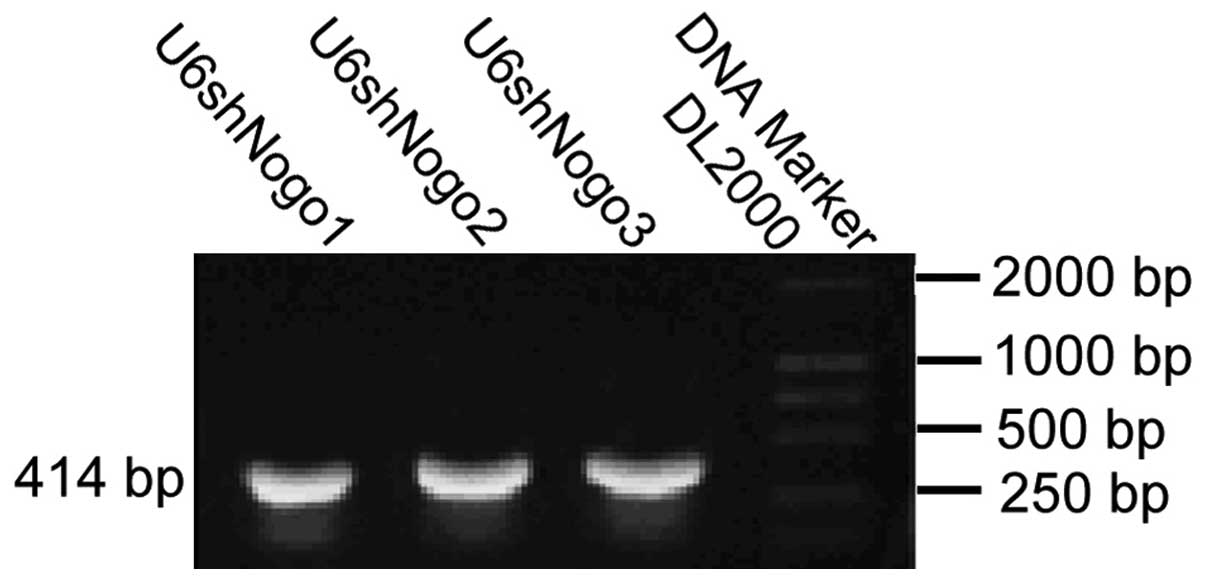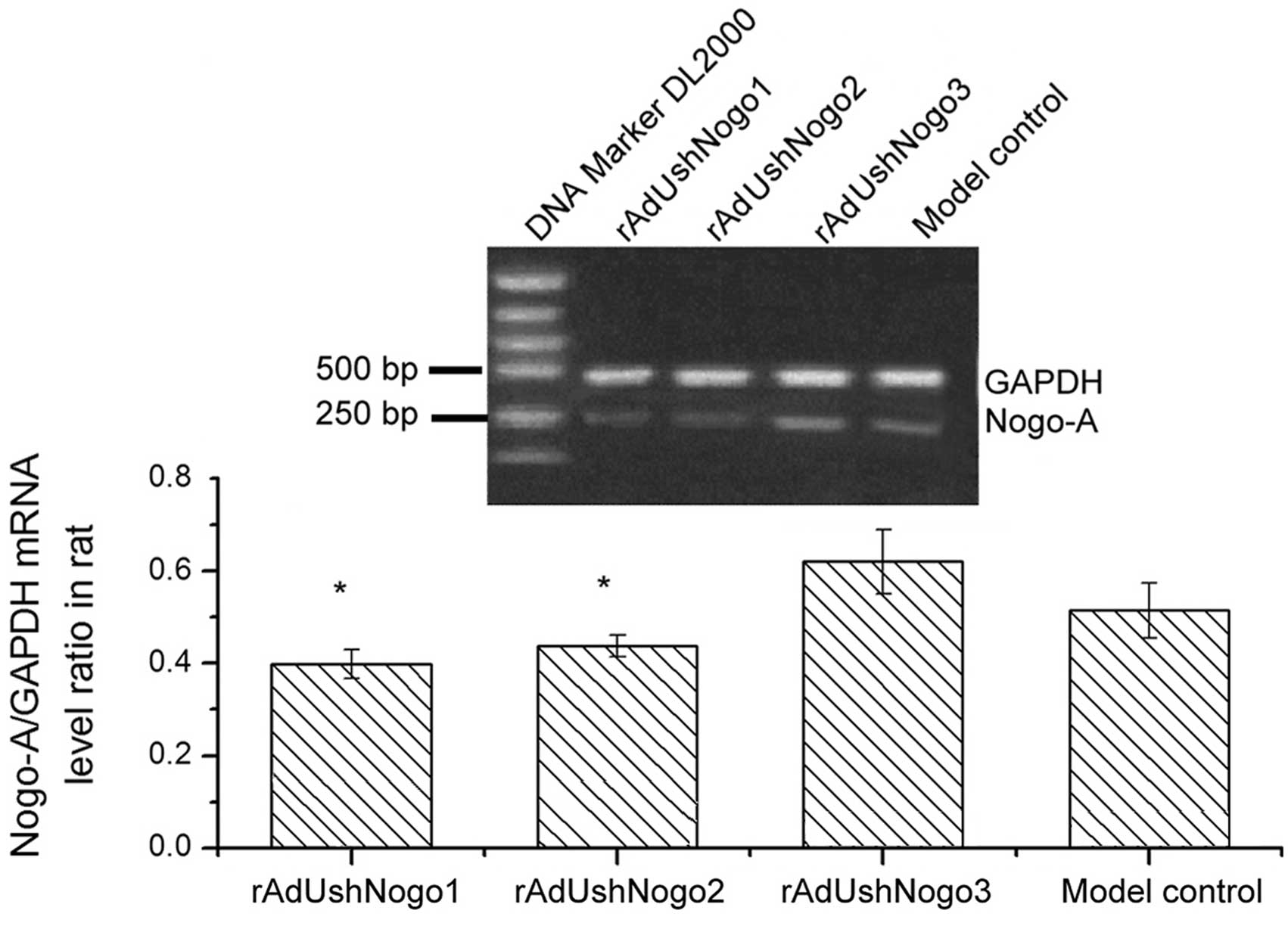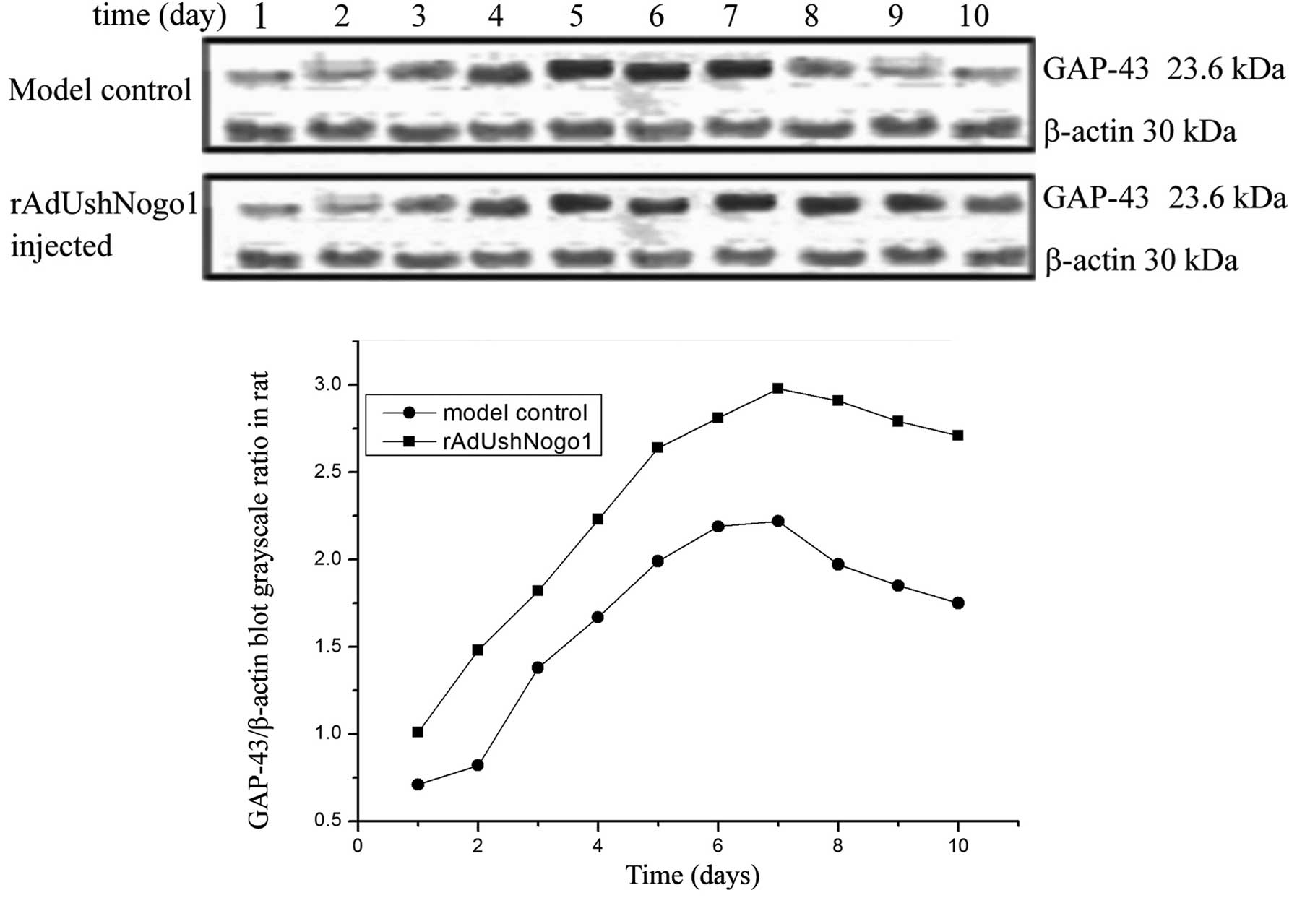|
1
|
Chytrova G, Ying Z and Gomez-Pinilla F:
Exercise normalizes levels of MAG and Nogo-A growth inhibitors
after brain trauma. Eur J Neurosci. 27:1–11. 2008. View Article : Google Scholar
|
|
2
|
Filbin MT: Myelin-associated inhibitors of
axonal regeneration in the adult mammalian CNS. Nat Rev Neurosci.
4:703–713. 2003. View
Article : Google Scholar : PubMed/NCBI
|
|
3
|
Chaudhry N and Filbin MT:
Myelin-associated inhibitory signaling and strategies to overcome
inhibition. J Cereb Blood Flow Metab. 27:1096–1107. 2007.
View Article : Google Scholar
|
|
4
|
Lenzlinger PM, Shimizu S, Marklund N,
Thompson HJ, Schwab ME, Saatman KE, Hoover RC, Bareyre FM, Motta M,
Luginbuhl A, et al: Delayed inhibition of Nogo-A does not alter
injury-induced axonal sprouting but enhances recovery of cognitive
function following experimental traumatic brain injury in rats.
Neuroscience. 134:1047–1056. 2005. View Article : Google Scholar : PubMed/NCBI
|
|
5
|
Chen MS, Huber AB, van der Haar ME, Frank
M, Schnell L, Spillmann AA, Christ F and Schwab ME: Nogo-A is
amyelin-associated neurite outgrowth inhibitor and an antigen for
monoclonal antibody IN-1. Nature. 403:434–439. 2000. View Article : Google Scholar : PubMed/NCBI
|
|
6
|
Fournier AE, GrandPre T and Strittmatter
SM: Identification of a receptor mediating Nogo-66 inhibition of
axonal regeneration. Nature. 409:341–346. 2001. View Article : Google Scholar : PubMed/NCBI
|
|
7
|
GrandPré T, Nakamura F, Vartanian T and
Strittmatter SM: Identification of the Nogo inhibitor of axon
regeneration as a Reticulon protein. Nature. 403:439–444. 2000.
View Article : Google Scholar : PubMed/NCBI
|
|
8
|
Prinjha R, Moore SE, Vinson M, Blake S,
Morrow R, Christie G, Michalovich D, Simmons DL and Walsh FS:
Inhibitor of neurite outgrowth in humans. Nature. 403:383–384.
2000. View
Article : Google Scholar : PubMed/NCBI
|
|
9
|
Liu BP, Cafferty WB, Budel SO and
Strittmatter SM: Extracellular regulators of axonal growth in the
adult central nervous system. Philos Trans R Soc Lond B Biol Sci.
361:1593–1610. 2006. View Article : Google Scholar : PubMed/NCBI
|
|
10
|
Domeniconi M, Cao Z, Spencer T,
Sivasankaran R, Wang K, Nikulina E, Kimura N, Cai H, Deng K, Gao Y,
et al: Myelin-associated glycoprotein interacts with the nogo66
receptor to inhibit neurite outgrowth. Neuron. 35:283–290. 2002.
View Article : Google Scholar : PubMed/NCBI
|
|
11
|
Otori Y, Wei JY and Barnstable CJ:
Neurotoxic effects of low doses of glutamate on purified rat
retinal ganglion cells. Invest Ophthalmol Vis Sci. 39:972–981.
1998.PubMed/NCBI
|
|
12
|
Ahmed Z, Dent RG, Suggate EL, Barrett LB,
Seabright RJ, Berry M and Logan A: Disinhibition of
neurotrophin-induced dorsal root ganglion cell neurite outgrowth on
CNS myelin by siRNA-mediated knockdown of NgR, p75NTR and Rho-A.
Mol Cell Neurosci. 28:509–523. 2005. View Article : Google Scholar : PubMed/NCBI
|
|
13
|
Acevedo L, Yu J, Erdjument-Bromage H, Miao
RQ, Kim JE, Fulton D, Tempst P, Strittmatter SM and Sessa WC: A new
role for Nogo as a regulator of vascular remodeling. Nat Med.
10:382–388. 2004. View
Article : Google Scholar : PubMed/NCBI
|
|
14
|
Marklund N, Fulp CT, Shimizu S, Puri R,
McMillan A, Strittmatter SM and McIntosh TK: Selective temporal and
regional alterations of Nogo-A and small proline-rich repeat
protein 1A (SPRR1A) but not Nogo-66 receptor (NgR) occur following
traumatic brain injury in the rat. Exp Neurol. 197:70–83. 2006.
View Article : Google Scholar
|
|
15
|
Buchli AD and Schwab ME: Inhibition of
Nogo: A key strategy to increase regeneration, plasticity and
functional recovery of the lesioned central nervous system. Ann
Med. 37:556–567. 2005. View Article : Google Scholar : PubMed/NCBI
|
|
16
|
Fouad K, Klusman I and Schwab ME:
Regenerating corticospinal fibers in the Marmoset (Callitrix
jacchus) after spinal cord lesion and treatment with the
anti-Nogo-A antibody IN-1. Eur J Neurosci. 20:2479–2482. 2004.
View Article : Google Scholar : PubMed/NCBI
|
|
17
|
Christman CW, Salvant JB Jr, Walker SA and
Povlishock JT: Characterization of a prolonged regenerative attempt
by diffusely injured axons following traumatic brain injury in the
adult cat: A light and electron microscopic immunocytochemical
study. Acta Neuropathol. 94:329–337. 1997. View Article : Google Scholar : PubMed/NCBI
|
|
18
|
Hulsebosch CE, DeWitt DS, Jenkins LW and
Prough DS: Traumatic brain injury in rats results in increased
expression of GAP-43 that corelates with behavioral recovery.
Neurosci Lett. 255:83–86. 1998. View Article : Google Scholar : PubMed/NCBI
|
|
19
|
Emery DL, Royo NC, Fischer I, Saatman KE
and McIntosh TK: Plasticity following injury to the adult central
nervous system: Is recapitulation of a developmental state worth
promoting? J Neurotrauma. 20:1271–1292. 2003. View Article : Google Scholar
|
|
20
|
Koda M, Hashimoto M, Murakami M, Yoshinaga
K, Ikeda O, Yamazaki M, Koshizuka S, Kamada T, Moriya H, Shirasawa
H, et al: Adenovirus vector-mediated in vivo gene transfer of
brain-derived neurotrophic factor (BDNF) promotes rubrospinal
axonal regeneration and functional recovery after complete
transection of the adult rat spinal cord. J Neurotrauma.
21:329–337. 2004. View Article : Google Scholar : PubMed/NCBI
|
|
21
|
Zhao YY, Yuan Y, Chen Y, Jiang L, Liao RJ,
Wang L, Zhang XN, Ohtsu H, Hu WW and Chen Z: Histamine promotes
locomotion recovery after spinal cord hemisection via inhibiting
astrocytic scar formation. CNS Neurosci Ther. 21:454–462. 2015.
View Article : Google Scholar : PubMed/NCBI
|
|
22
|
Zhang Q, Shao Y, Zhao C, Cai J and Sun S:
N-methyl-D-aspartate receptor antagonist MK-801 prevents apoptosis
in rats that have undergone fetal spinal cord transplantation
following spinal hemisection. Exp Ther Med. 8:1731–1736.
2014.PubMed/NCBI
|
|
23
|
Latini L, Bisicchia E, Sasso V, Chiurchiù
V, Cavallucci V, Molinari M, Maccarrone M and Viscomi MT:
Cannabinoid CB2 receptor (CB2R) stimulation delays rubrospinal
mitochondrial-dependent degeneration and improves functional
recovery after spinal cord hemisection by ERK1/2 inactivation. Cell
Death Dis. 5:e14042014. View Article : Google Scholar : PubMed/NCBI
|
|
24
|
Grosso MJ, Matheus V, Clark M, van Rooijen
N, Iannotti CA and Steinmetz MP: Effects of an immunomodulatory
therapy and chondroitinase after spinal cord hemisection injury.
Neurosurgery. 75:461–471. 2014. View Article : Google Scholar : PubMed/NCBI
|
|
25
|
Yang J, Han Y, Ye W, Liu F, Zhuang K and
Wu G: Alpha tocopherol treatment reduces the expression of Nogo-A
and NgR in rat brain after traumatic brain injury. J Surg Res.
182:e69–e77. 2013. View Article : Google Scholar
|
|
26
|
Yan M, Yang M, Shao W, Mao XG, Yuan B,
Chen YF, Ye ZX, Liang W and Luo ZJ: High-dose ascorbic acid
administration improves functional recovery in rats with spinal
cord contusion injury. Spinal Cord. 52:803–808. 2014. View Article : Google Scholar : PubMed/NCBI
|
|
27
|
Kaneko A, Matsushita A and Sankai Y: A 3D
nanofibrous hydrogel and collagen sponge scaffold promotes
locomotor functional recovery, spinal repair, and neuronal
regeneration after complete transection of the spinal cord in adult
rats. Biomed Mater. 10:0150082015. View Article : Google Scholar : PubMed/NCBI
|
|
28
|
Xian-Hui D, Xiao-Ping H and Wei-Juan G:
Neuroprotective effects of the Buyang Huanwu decoction on
functional recovery in rats following spinal cord injury. J Spinal
Cord Med. Oct 20–2014.Epub ahead of print. PubMed/NCBI
|
|
29
|
Yamaya S, Ozawa H, Kanno H, Kishimoto KN,
Sekiguchi A, Tateda S, Yahata K, Ito K, Shimokawa H and Itoi E:
Low-energy extracorporeal shock wave therapy promotes vascular
endothelial growth factor expression and improves locomotor
recovery after spinal cord injury. J Neurosurg. 121:1514–1525.
2014. View Article : Google Scholar : PubMed/NCBI
|
|
30
|
Zhang J, Liu Z, Chen H, Duan Z, Zhang L,
Chen L and Li B: Synergic effects of EPI-NCSCs and OECs on the
donor cells migration, the expression of neurotrophic factors, and
locomotor recovery of contused spinal cord of rats. J Mol Neurosci.
55:760–769. 2015. View Article : Google Scholar
|
|
31
|
Basso DM, Beattie MS and Bresnahan JC: A
sensitive and reliable locomotor rating scale for open field
testing in rats. J Neurotrauma. 12:1–21. 1995. View Article : Google Scholar : PubMed/NCBI
|
|
32
|
Spencer T, Domeniconi M, Cao Z and Filbin
MT: New roles for old proteins in adult CNS axonal regeneration.
Curr Opin Neurobiol. 13:133–139. 2003. View Article : Google Scholar : PubMed/NCBI
|
|
33
|
Schwab ME: Nogo and axon regeneration.
Curr Opin Neurobiol. 14:118–124. 2004. View Article : Google Scholar : PubMed/NCBI
|
|
34
|
Filbin MT: Recapitulate development to
promote axonal regeneration: Good or bad approach? Philos Trans R
Soc Lond B Biol Sci. 361:1565–1574. 2006. View Article : Google Scholar : PubMed/NCBI
|
|
35
|
Wang XY and Zhang JT: Effects of
ginsenoside Rg1 on synaptic plasticity of freely moving rats and
its mechanism of action. Acta Pharmacol Sin. 22:657–662.
2001.PubMed/NCBI
|
|
36
|
Hassiotis M, Ashwell KW, Marotte LR,
Lensing-Höhn S and Mai JK: GAP-43 Immunoreactivity in the brain of
the developing and adult wallaby (Macropus eugenii). Anat Embryol
(Berl). 206:97–118. 2002. View Article : Google Scholar
|
|
37
|
Tolner EA, van Vliet EA, Holtmaat AJ,
Aronica E, Witter MP, da Silva FH and Gorter JA: GAP-43 mRNA and
protein expression in the hippocampal and parahippocampal region
during the course of epileptogenesis in rats. Eur J Neurosci.
17:2369–2380. 2003. View Article : Google Scholar : PubMed/NCBI
|
|
38
|
Carrasco J, Penkowa M, Giralt M, Camats J,
Molinero A, Campbell IL, Palmiter RD and Hidalgo J: Role of
metallothionein-III following central nervous system damage.
Neurobiol Dis. 13:22–36. 2003. View Article : Google Scholar : PubMed/NCBI
|
|
39
|
McIlvain VA, Robertson DR, Maimone MM and
McCasland JS: Abnormal thalamocortical pathfinding and terminal
arbors lead to enlarged barrels in neonatal GAP-43 heterozygous
mice. J Comp Neurol. 462:252–264. 2003. View Article : Google Scholar : PubMed/NCBI
|














